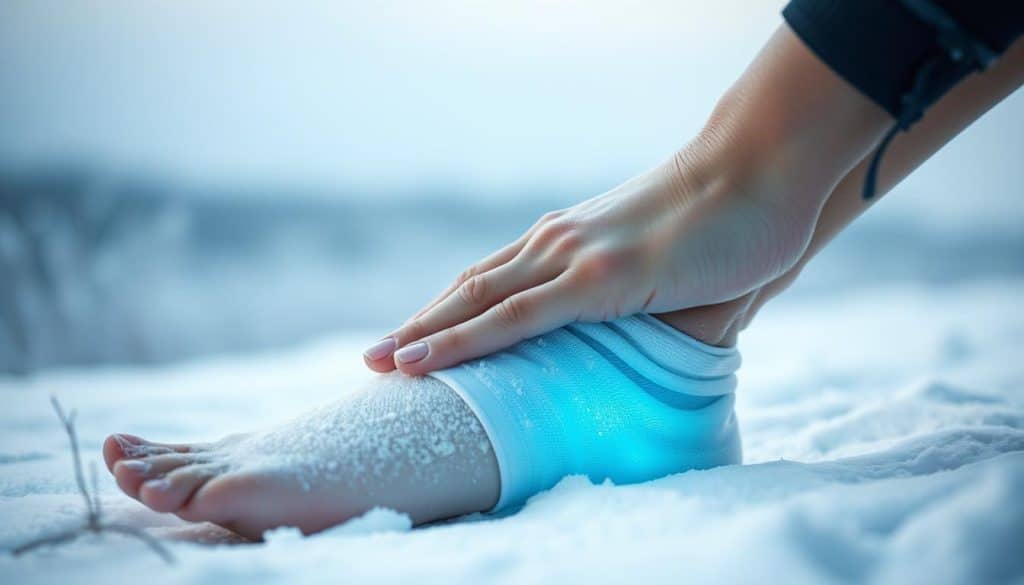For centuries, people have turned to temperature-based treatments to ease discomfort and speed up healing. Whether soothing sore muscles or calming swollen joints, warm and cold applications remain popular for post-injury or exercise care. Experts like Rebecca Kurtz from Henry Ford Health note these methods work by targeting blood flow and tissue response.
Warmth encourages relaxation in tight areas, boosting circulation to deliver nutrients faster. Cold, on the other hand, numbs sharp pain and limits swelling by constricting blood vessels. Johns Hopkins Medicine highlights that timing matters—most sessions last 15–20 minutes to avoid skin damage.
Choosing between the two depends on your injury type and recovery stage. For personalized advice, contact Riverside Sports Therapy in Calgary, AB, Canada. Their team tailors treatments to individual needs, ensuring safe and effective results.
Key Takeaways
- Temperature-based treatments have been used for centuries to manage pain and promote healing.
- Warm applications improve blood flow and relax muscles, while cold reduces swelling.
- Experts recommend limiting sessions to 15–20 minutes for safety.
- Riverside Sports Therapy in Calgary offers customized recovery plans.
- The right choice depends on injury type, timing, and individual needs.
Exploring the Benefits of Heat Therapy
Warmth has long been a trusted ally for easing tension and supporting natural healing processes. By gently raising tissue temperature, it creates a cascade of benefits that aid physical restoration. As Rebecca Kurtz explains, “Controlled warmth triggers blood vessel expansion, allowing oxygen and nutrients to reach strained areas more efficiently.”

Boosting Circulation for Faster Relief
When applied correctly, warmth encourages blood vessels to widen. This increased circulation helps flush out waste products while delivering essential nutrients to sore muscles. Studies show sessions lasting 15–20 minutes optimize results without risking skin irritation.
| Effect | Warmth Application | Cold Application |
|---|---|---|
| Blood Flow | Increases by 40-50% | Reduces by 30-40% |
| Muscle Tightness | Decreases stiffness | May temporarily increase |
| Ideal Use Case | Chronic stiffness | Acute swelling |
Supporting Post-Workout Recovery
After intense physical activity, warmth helps loosen contracted muscle fibers. Techniques like moist heating pads or warm baths provide deep relaxation. Professionals at Riverside Sports Therapy often recommend combining these methods with proper hydration to maximize recovery.
“Hydration enhances warmth-based treatment effectiveness by maintaining optimal fluid balance in tissues.”
Key safety tips include:
- Test heat sources on sensitive skin areas first
- Avoid falling asleep with electric heating devices
- Combine with gentle stretching for improved mobility
For chronic conditions or recurring stiffness, Calgary-based specialists suggest personalized plans that may alternate between temperature techniques for sustained relief.
Unpacking the Advantages of Ice Therapy
Cold applications have become a cornerstone in managing sudden injuries and post-activity discomfort. When applied correctly, they create targeted physiological responses that support healing. Johns Hopkins Medicine research confirms cold reduces tissue temperature by 12-15°F, slowing cellular activity to prevent excessive fluid buildup.

Using Cold to Lessen Inflammation and Swelling
Immediate use of cold packs after trauma constricts blood vessels, limiting internal bleeding and swelling. Experts recommend wrapping gel packs or crushed ice in a thin towel before placing them on the affected area. This protects skin while allowing therapeutic cooling.
Most acute injuries benefit from 15-20 minute sessions every 2-3 hours during the first two days. “Timing is critical,” notes a Johns Hopkins specialist. “Overuse can cause tissue damage, while underuse delays recovery.” For exercise-induced soreness, brief cold exposure helps manage stiffness without hindering mobility.
Effective methods include:
- Ice baths (10-15 minutes) for full-body recovery
- Cold compresses for localized joint injuries
- Commercial gel packs for precise temperature control
Athletes in Calgary often combine these approaches with professional guidance from local clinics. Proper cold treatment protocols reduce downtime by 30-40% in acute cases, according to recent studies.
Heat vs ice therapy recovery: Choosing the Right Method for Your Injury
Understanding when to apply warmth or cold can significantly impact healing outcomes. The choice depends on injury type, timing, and tissue response. Acute injuries like sprains often benefit from cold to reduce swelling, while chronic stiffness responds better to warmth.
Determining When to Use Cold Versus Warm Treatments
Use ice packs during the first 48 hours after sudden injuries. Cold constricts blood vessels, slowing fluid buildup. For persistent muscle tension, moist heat pads improve flexibility by relaxing tissues. A 20-minute cold session followed by 15 minutes of warmth creates a “pumping” effect, enhancing nutrient delivery.
Alternating Therapies Safely for Optimized Recovery
Alternating methods boosts circulation without overloading tissues. Wrap gel packs in cloth to prevent frostbite. Heating pads should stay below 104°F to avoid burns. Professionals recommend 3-4 cycles daily for stubborn conditions.
Expert Guidance From Riverside Sports Therapy in Calgary
“Individualized plans yield the best results,” says a Riverside therapist. Their team assesses injury age, pain levels, and tissue health to design tailored routines. Contact them at 403-555-0123 or visit RiversideSports.ca for personalized strategies.
“Combining temperature therapies accelerates recovery by 25% in chronic cases when timed correctly.”
Key safety tips include:
- Never apply ice directly to skin
- Check heating devices for consistent temperature
- Stop treatment if numbness or redness occurs
Conclusion
Recovery strategies often hinge on selecting the right approach for your body’s needs. Warm applications boost blood flow to ease stiffness, while cold methods target swelling in sensitive joints. Both play vital roles in managing discomfort when timed correctly—typically 15–20 minutes per session with protective layers like a towel.
For persistent back pain or joint aches, understanding treatment types matters. Consistent warmth relaxes tight muscles, and controlled cold reduces inflammation. Always prioritize safety: avoid extreme temperatures and follow expert guidelines to prevent tissue damage.
Struggling to choose? Riverside Sports Therapy in Calgary tailors plans to your unique recovery goals. Call them at (403) 283-7551 for advice on combining these treatments effectively. Their team ensures proper application techniques and durations for lasting relief.
Balancing these methods with care accelerates healing and minimizes downtime. Whether easing daily aches or recovering from strain, informed decisions paired with professional support lead to better outcomes. Take charge of your well-being—knowledge and action work best together.
